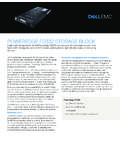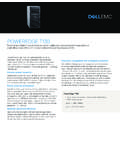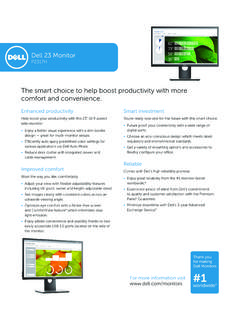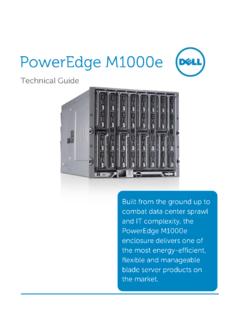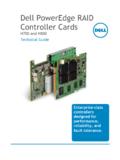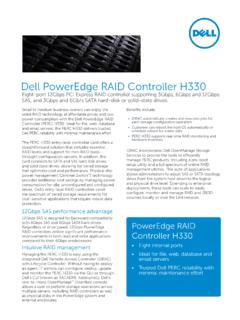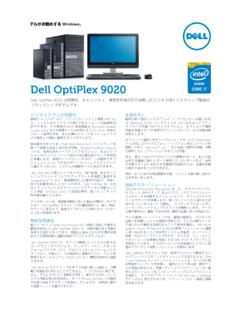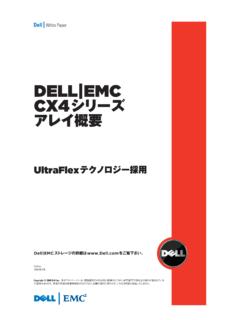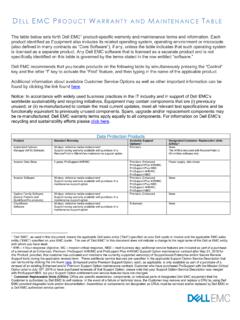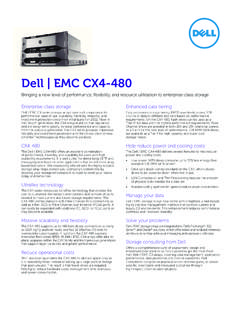Transcription of DELL | EMC CX4 VIRTUAL PROVISIONING OVERVIEW
1 dell Inc. Visit for more information on dell /EMC Storage. Copyright 2008 dell Inc. THIS WHITE PAPER IS FOR INFORMA-TIONAL PURPOSES ONLY, AND MAY CONTAIN TYPOGRAPHICAL ERRORS AND TECHNICAL INACCURACIES. THE CONTENT IS PRO-VIDED AS IS, WITHOUT EXPRESS OR IMPLIED WARRANTIES OF ANY KIND. dell | EMC CX4 VIRTUAL PROVISIONING OVERVIEW CONTENTS EXECUTIVE SUMMARY 3 INTRODUCTION 3 Terminology 4 BUSINESS REQUIREMENTS 5 COMPARING TRADITIONAL LUNS AND THIN LUNS 5 THIN POOLS 6 Monitoring, adding, and deleting thin pool capacity 7 THIN LUNS 7 Attributes 8 Architecture and features 8 USING THIN LUNS WITH APPLICATIONS 9 Oracle 10 Microsoft SQL Server 10 Microsoft Exchange 10 VMware 11 Traditional LUNs versus thin LUNs 11 LUN migration 11 PHASED IMPLEMENTATION FOR VIRTUAL PROVISIONING 12 CONCLUSION 12 APPENDIX A: THIN POOL PROPERTIES 13 APPENDIX B: THIN LUN PROPERTIES 14 FIGURES FIGURE 1: TRADITIONAL STORAGE PROVISIONING 5 FIGURE 2: THIN PROVISIONING 6 FIGURE 3: CREATE STORAGE POOL DIALOG BOX 6 FIGURE 4: POOL % FULL THRESHOLD 7 FIGURE 5.
2 STORAGE POOLS IN NAVISPHERE MANAGER 8 FIGURE 6: LUN THRESHOLD AND ALLOCATION LIMIT 8 FIGURE 7: RESERVED CAPACITY 9 FIGURE 8: LUN MIGRATION 12 dell /EMC CX4 VIRTUAL PROVISIONING OVERVIEW EXECUTIVE SUMMARY VIRTUAL PROVISIONING helps enable organizations to reduce storage costs by increasing capacity utilization, simplifying storage management, and reducing application downtime. VIRTUAL Provision-ing also helps companies reduce power and cooling requirements and delay capital expenditures. The dell /EMC CX4 series introduces thin LUN technology that builds on current VIRTUAL LUN capa-bilities and seamlessly integrates with existing EMC management and replication software. With dell /EMC CX4 VIRTUAL PROVISIONING , you can choose between traditional LUNs, metaLUNs, and thin LUNs. The ability to non-disruptively migrate data to different LUN and disk types allows you to deploy the best solution for your changing application and business requirements without incur-ring downtime.
3 dell /EMC CX4 thin LUN technology also supports features such as hot sparing, proactive sparing, and the ability to migrate data between thin LUNs, traditional LUNs, and metaLUNs without incur-ring application downtime. This flexibility helps separate CX4 VIRTUAL PROVISIONING from typical thin PROVISIONING implementations. INTRODUCTION One of the biggest challenges facing storage administrators is balancing how much storage space will be required by the various applications in their data centers. Administrators are typically forced to allocate space based on anticipated storage growth. They do this to reduce the management expense and application downtime required to add storage later on. This generally results in the over- PROVISIONING of storage capacity. Over- PROVISIONING leads to higher costs; increased power, cooling, and floor space requirements; and lower capacity utilization rates.
4 Even with careful plan-ning, it may be necessary to provision additional storage in the future. This may require application downtime depending on the operating systems involved. To address these concerns, the dell /EMC CX4 series introduces thin LUN technology. This tech-nology works with current dell /EMC metaLUNs and traditional LUNs to provide powerful, cost-effective, flexible solutions. dell /EMC CX4 thin LUNs present more storage to an application than is physically available. Storage managers are freed from the time-consuming administrative work of deciding how to allocate disk drive capacity. Instead, an array-based mapping service builds and maintains all of the storage structures based on a few high-level user inputs. Disk drives are grouped into storage pools that form the basis for PROVISIONING actions. Physical storage is auto-matically allocated only when writing new data blocks.
5 Thin PROVISIONING helps improve storage capacity utilization and simplifies storage management by presenting an application with sufficient capacity for an extended period of time. When additional physical storage space is required, disk drives can be non-disruptively added to the central stor-age pool. This reduces the time and effort required to provision additional storage, and avoids pro-visioning storage that may not be needed. You manage thin LUNs using the same Navisphere Manager GUI and Secure CLI commands that you use to manage traditional LUNs and metaLUNs. EMC replication products, Navisphere Analyzer, and Navisphere Quality of Service Manager work seamlessly across thin LUNs, tradi-tional LUNs, and metaLUNs. This white paper discusses: How thin LUNs help deliver space efficiency and make it easier to provision storage How dell /EMC CX4 series arrays implement PROVISIONING for thin LUNs How thin LUNs and thin pools compare with traditional LUNs and RAID groups The types of file systems and applications that are best suited for thin PROVISIONING 3 AUGUST 2008 dell /EMC CX4 VIRTUAL PROVISIONING OVERVIEW Terminology The following terminology appears in this white paper: % Full The percentage of pool capacity that is currently allocated.
6 It is calculated using this formula: % Full = Allocated capacity / usable pool capacity % Full Threshold A parameter that is set by the user. The system generates an alert when this threshold is exceeded. Allocated capacity The amount of actual physical thin pool space that is currently allo-cated for thin LUNs. Available capacity The amount of actual physical thin pool space that is currently not allocated for thin LUNs. Consumed capacity The amount of the thin pool that has been reserved and/or allocated for all the thin LUNs in the pool. LUN migration A dell /EMC feature that dynamically migrates data to another LUN or metaLUN without disrupting running applications. LUN migration has many uses, for example: To change the type of disk drive (for example, from economical SATA to faster FC, or vice versa) To select a RAID type that better matches the current performance or availability re-quirements To re-create a LUN with more disk space After migration is complete, the destination LUN assumes the identity (World Wide Name and other IDs) of the source LUN, and the source LUN is destroyed.
7 LUN migration can be tuned by setting it to one of four speed settings: Low, Medium, High, or ASAP. MetaLUN A collection of traditional LUNs that are striped or concatenated together and presented to a host as a single LUN. A single metaLUN can be striped across any number of disk spindles, providing a much wider range of performance and configuration options. Addi-tional LUNs can be added dynamically, allowing metaLUNs to be expanded on the fly. Oversubscribed capacity The amount of usable pool capacity configured for thin LUNs that exceeds the actual usable pool capacity. RAID group A type of storage pool that contains a set of disks on which traditional LUNs and metaLUNs can be created. Storage Pool A general term used to describe RAID groups and thin pools. In the Nav-isphere Manager GUI, the storage pool node contains RAID groups and thin pool nodes.
8 Subscribed capacity The total amount of thin LUN user capacity configured in the pool. This number can be greater than the usable pool capacity. The usable pool capacity can be expanded so that it can accommodate the subscribed user capacity as more space is allo-cated for the thin LUNs in the pool. Thin LUN A logical unit of storage where physical space allocated on the storage system may be less than the user capacity seen by the host server. Thin pool A group of disk drives used specifically by thin LUNs. There may be zero or more thin pools on a system. Disks may be a member of no more than one thin pool. Disks that are in a thin pool cannot also be in a RAID group. Threshold alert An alert issued when the % Full Threshold has been exceeded. Total user capacity The total capacity seen by all hosts using a thin pool. Traditional LUN A logical unit of storage that can span a number of disks on a storage system but looks like a single disk or partition to the server.
9 The amount of physical space allocated is the same as the user capacity seen by the host server. Usable pool capacity Pool capacity measured as raw capacity minus overhead (RAID overhead and mapping overhead). User capacity This is also referred to as reported capacity. This is the size of the thin LUN as it appears to the host. This term also applies to traditional LUNs, where allocated capacity equals user capacity. 4 AUGUST 2008 dell /EMC CX4 VIRTUAL PROVISIONING OVERVIEW BUSINESS REQUIREMENTS Organizations, both large and small, need to reduce the cost of managing their storage infrastruc-ture while meeting rigorous service level requirements and accommodating explosive storage ca-pacity growth. Several business objectives have drawn increasing focus: Reducing the cost of storage administration Ease of use initiatives span multiple aspects of storage processes, including staff training, initial storage PROVISIONING , the addition of new storage, and the management and monitoring of storage systems.
10 VIRTUAL PROVISIONING helps reduce the ongoing staff time required to repeatedly add stor-age capacity. Maximizing the utilization of storage assets Organizations need to accommodate growth by drawing more value from the same or fewer stor-age resources. Operational efficiency remains an ongoing challenge, as organizations often over-allocate storage to applications to reduce the risk of outage and the need to re-provision later on. Reducing capital expenditures and ongoing costs VIRTUAL PROVISIONING helps reduce capital costs by delivering storage capacity on-demand. Ongoing costs can be reduced because fewer disks consume less power and cooling, and take up less floor space. COMPARING TRADITIONAL LUNS AND THIN LUNS Storage PROVISIONING is the process of assigning storage resources to meet the capacity, availabil-ity, and performance needs of applications.
